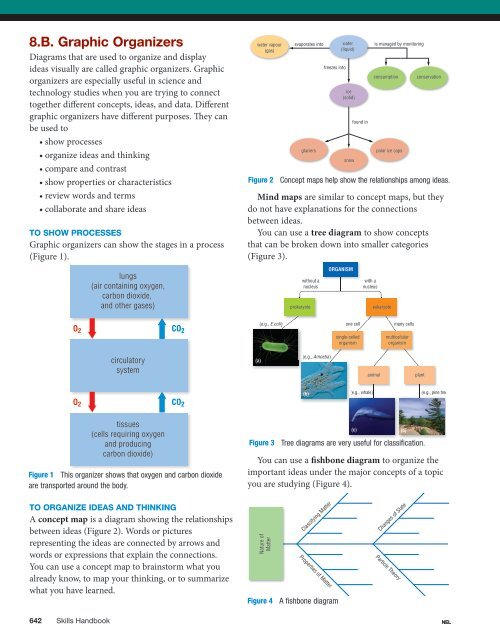PRE-PUBLICA TION EDITION - Nelson Education
PRE-PUBLICA TION EDITION - Nelson Education
PRE-PUBLICA TION EDITION - Nelson Education
You also want an ePaper? Increase the reach of your titles
YUMPU automatically turns print PDFs into web optimized ePapers that Google loves.
8.B. Graphic OrganizersDiagrams that are used to organize and displayideas visually are called graphic organizers. Graphicorganizers are especially useful in science andtechnology studies when you are trying to connecttogether different concepts, ideas, and data. Differentgraphic organizers have different purposes. They canbe used to• show processes• organize ideas and thinking• compare and contrast• show properties or characteristics• review words and terms• collaborate and share ideasTo Show ProcessesGraphic organizers can show the stages in a process(Figure 1).lungs(air containing oxygen,carbon dioxide,and other gases)water vapour(gas)evaporates intoPlant and Animal CellsBiology as a science is built on three simple found in but very important ideas. Thesethree ideas form the cell theory. The cell theory states that1. All living things are made up of one or more cells and their products.2. The cell is the simplest unit that can carry out all life processes.glacierspolar ice caps3. All cells come from other cells; they do not come fromsnownon-living matter.All living things are made up of cells, but these cells may be very simple orvery complex. The simplest organisms are archaea and bacteria. These simple,single-celled life forms are called prokaryotes (Figure 1(a)). The cells do nothave Mind a nucleus. maps More are complex similar cells can to exist concept as single-celled maps, organisms but they ormulticellular organisms. The cells of these organisms, known as eukaryotes,have a more complex internal organization, including a nucleus. Eukaryotesinclude all protists, fungi, animals, and plants, from the tiniest Amoeba to thelongest whale and the tallest tree (Figure 1(b) to (d)). The cells of eukaryotesare You much can larger use than a the tree cells diagram of prokaryotes: to tens show to thousands concepts of timeslarger. There are even some eukaryotes—beyond the scope of this unit—thatare made up of one huge cell with very many nuclei.prokaryotewithout anucleusfreezes intowater(liquid)ice(solid)ORGANISMwith anucleusis managed by monitoringconsumptiondo not have explanations for the connectionsbetween ideas.eukaryoteconservationFigure 2 Concept maps help show the relationships among ideas.that can be broken down into smaller categories(Figure 3).cell theory a theory that allare made up of one or morecells are the basic unit of lifecells come from pre-existingprokaryote a cell that doesa nucleus or other membranorganelleseukaryote a cell that contaiand other organelles, each sa thin membraneREADING TIPMaking ConnectionsWhen trying to make connwith a text, use prompts osuch as:O 2 CO 2(e.g., E.coli) )one cellsingle-celledorganismmany cellsmulticellularorganismcirculatorysystem(a)(e.g., Amoeba)animalplantO 2 CO 2tissues(cells requiring oxygenand producingcarbon dioxide)Figure 1 This organizer shows that oxygen and carbon dioxideare transported around the body.(b)(e.g., whale)(c)(e.g., pine tree)(d)Figure 3 Tree diagrams are very useful for classification.Cell StructureYour body is made up of many specialized organs that carry out all theprocesses can needed use to a live. fishbone In the same way, diagram a eukaryotic to cell organize also has specialized theimportant parts, called organelles, ideas under that carry the out major specific functions concepts necessary of for a topic life.you are studying (Figure 4).NELFigure 1 The relationshipprokaryotes and eukaryotbacterium (a) is a prokaryAmoeba (b), the whale (c)the pine tree (d) are all euorganelle a cell structure thspecifi c function for the cell2.1 Plant and AnimalTo Organize Ideas and ThinkingA concept map is a diagram showing the relationshipsbetween ideas (Figure 2). Words or picturesrepresenting the ideas are connected by arrows andwords or expressions that explain the connections.You can use a concept map to brainstorm what youalready know, to map your thinking, or to summarizewhat you have learned.Nature ofMatterClassifying MatterProperties of MatterFigure 4 A fishbone diagramChanges of StateParticle Theory642 Skills Handbook NEL
















